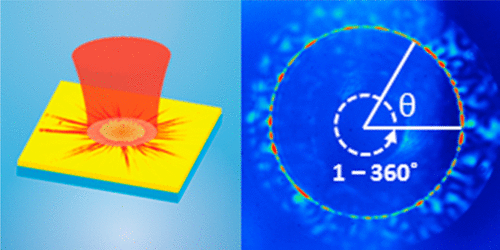当前位置:
X-MOL 学术
›
ACS Photonics
›
论文详情
Our official English website, www.x-mol.net, welcomes your
feedback! (Note: you will need to create a separate account there.)
On-Chip Spectropolarimetry by Fingerprinting with Random Surface Arrays of Nanoparticles
ACS Photonics ( IF 6.5 ) Pub Date : 2018-01-03 00:00:00 , DOI: 10.1021/acsphotonics.7b01059 Yiting Chen 1 , Fei Ding 1 , Victor Coello 2 , Sergey I. Bozhevolnyi 1
ACS Photonics ( IF 6.5 ) Pub Date : 2018-01-03 00:00:00 , DOI: 10.1021/acsphotonics.7b01059 Yiting Chen 1 , Fei Ding 1 , Victor Coello 2 , Sergey I. Bozhevolnyi 1
Affiliation

|
Optical metasurfaces revolutionized the approach to mold the propagation of light by enabling simultaneous control of the light phase, momentum, amplitude, and polarization. Thus, instantaneous spectropolarimetry became possible by conducting parallel intensity measurements of differently diffracted optical beams. Various implementations of this very important functionality have one feature in common: the determination of wavelength utilizes dispersion of the diffraction angle, requiring tracking the diffracted beams in space. Realization of on-chip spectropolarimetry calls thereby for conceptually different approaches. In this work, we demonstrate that random nanoparticle arrays on metal surfaces, enabling strong multiple scattering of surface plasmon polaritons (SPPs), produce upon illumination complicated SPP scattered patterns, whose angular spectra are uniquely determined by the polarization and wavelength of light, representing thereby spectropolarimetric fingerprints. Using micrometer-sized circular arrays of randomly distributed nanometer-sized gold nanoparticles (density ∼75 μm–2) fabricated on gold films, we measure angular distributions of scattered SPP waves using the leakage radiation microscopy and find that the angular SPP spectra obtained for normally incident light beams different in wavelength and/or polarization are distinctly different. Our approach allows one to realize on-chip spectropolarimetry by fingerprinting using surface nanostructures fabricated with simple one-step electron-beam lithography.
中文翻译:

通过指纹与纳米粒子的随机表面阵列进行的片上光谱极化分析。
通过同时控制光的相位,动量,振幅和偏振,光学超表面彻底改变了模制光传播的方法。因此,通过对不同衍射光束进行平行强度测量,可以实现瞬时光谱极化法。这个非常重要的功能的各种实现方式具有一个共同的特征:波长的确定利用了衍射角的色散,需要跟踪空间中的衍射光束。芯片上的光谱极化技术的实现因此需要概念上不同的方法。在这项工作中,我们证明了金属表面上的随机纳米颗粒阵列可实现表面等离振子极化子(SPP)的强多次散射,在照明时会产生复杂的SPP散射图案,其角光谱由光的偏振和波长唯一地确定,从而代表了光谱偏振指纹。使用随机分布的纳米级金纳米粒子(密度约75μm)的微米级圆形阵列–2)制作在金膜上,我们使用泄漏辐射显微镜测量了散射SPP波的角分布,发现对于波长和/或偏振不同的法向入射光束获得的角SPP光谱有明显不同。我们的方法允许人们通过使用简单的一步式电子束光刻技术制造的表面纳米结构通过指纹识别来实现芯片上的光谱极化法。
更新日期:2018-01-03
中文翻译:

通过指纹与纳米粒子的随机表面阵列进行的片上光谱极化分析。
通过同时控制光的相位,动量,振幅和偏振,光学超表面彻底改变了模制光传播的方法。因此,通过对不同衍射光束进行平行强度测量,可以实现瞬时光谱极化法。这个非常重要的功能的各种实现方式具有一个共同的特征:波长的确定利用了衍射角的色散,需要跟踪空间中的衍射光束。芯片上的光谱极化技术的实现因此需要概念上不同的方法。在这项工作中,我们证明了金属表面上的随机纳米颗粒阵列可实现表面等离振子极化子(SPP)的强多次散射,在照明时会产生复杂的SPP散射图案,其角光谱由光的偏振和波长唯一地确定,从而代表了光谱偏振指纹。使用随机分布的纳米级金纳米粒子(密度约75μm)的微米级圆形阵列–2)制作在金膜上,我们使用泄漏辐射显微镜测量了散射SPP波的角分布,发现对于波长和/或偏振不同的法向入射光束获得的角SPP光谱有明显不同。我们的方法允许人们通过使用简单的一步式电子束光刻技术制造的表面纳米结构通过指纹识别来实现芯片上的光谱极化法。











































 京公网安备 11010802027423号
京公网安备 11010802027423号